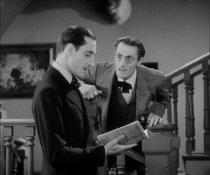
Vance with Pardee, one of the most
suspicious-looking characters in the film. |
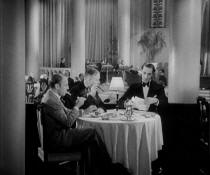
The Stuyvesant Club--a favorite Vance hangout |
"This is that mystery story of Van Dine's in which the murders all
correspond in a grimly fantastic way to nursery rhymes, beginning with
Cock Robin and ending with Little Miss Muffet. It is nicely done,
with Basil Rathbone performing excellently as the famous Philo Vance."
—Educational Screen, March 1930
The Bishop Murder Case
Another one of S.S. Van Dine's swell mystery stories comes to the
screen. Since this was made my Metro-Goldwyn and Bill Powell is a
Paramount star, they had to find another Philo Vance. Basil Rathbone
plays him well—but his performance
doesn't equal Powell's characterization. The production is excellent
and this story of wholesale murder to the accompaniment of
mysteriously worded nursery rhymes is absorbing in movie form.
Excellent performances by Alec Francis, George Marion and Leila Hyams.
You will miss Bill Powell, but this mystery film is well worth seeing.
—New Movie, March 1930 |
"The Bishop Murder Case is an almost perfect picturization of my book.
It has been splendidly conceived and splendidly done."
—S.S. Van Dine, quoted in Exhibitors
Daily Review and Motion Pictures Today, February 3, 1930
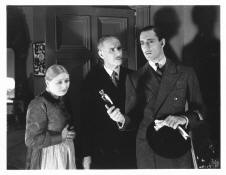
Markham, Vance, and the Drukker's housekeeper find the body of Miss
Drukker. |
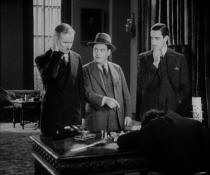
Markham, Heath and Vance find Pardee dead. |
"This is an excellently rounded production which cannot fail to appeal to
lovers of detective fiction. The story is a good one, and its mystifying
atmosphere has been preserved by intelligent casting and direction. It is
recommended as unusually good of its type." —Motion Picture Reviews,
1930
The Bishop Murder Case
With Paramount already having proved the S.S. Van Dine Philo Vance
stories excellent screen mystery entertainment, M-G-M cinches the
proposition with "The Bishop Murder Case." One studio seems to have
done as well as the other in translating these master-mind detective
yarns to the screen, with Paramount's edge being that William Powell
makes a better Philo than M-G-M's candidate, Basil Rathbone. Also
Eugene Pallette has more on the Van Dine dumb dick character than has
James Donlon of the M-G-M version. Offsetting which, Roland Young
gives a performance in the present instance which has not been
equalled by any of the supporting cast in the Paramount Vance
offerings.
Why, however, these stories are forthcoming from two studios is not
easily understood. Illusion certainly will be destroyed for both by
seeing the same man thus portrayed by different actors.
As with the run of Van Dine's yarns, this one doesn't depend on the
thrill stuff for its effectiveness. There is an absence of sliding
panels, groping hands, sudden shrieks and the like. It is a mental
gymnastic for the audience, with several murders interspersed to
increase the tangle and to bring suspicions of various of the
characters to an abrupt halt.
Because of the familiarity of the series and their likeness in
general structure, there is no need to rehearse the story here.
Suffice to say that suspicion is well cast about, four characters
having the accusing finer definitely pointing at them at different
periods of the story. The denouement is well calculated to surprise
exceedingly, and yet is extremely logical. In other words a first-rate
story. Love interest is nil.
EXHIBITORS' VIEWPOINT: Another of the Class A mystery films, and as
such a mighty good booking for houses where this stuff draws. Of
course it's great for the kids.
PRODUCERS' VIEWPOINT: With the exception of not eliminating
confusion as to the relationship of several characters to one another
in the beginning, and coincidentally not definitely explaining their
status in the situations evolving, direction by Nick Grinde and David
Burton was up to all demands. Requirements were for straightaway story
development only, with no nuances of emotionalism, and this they did
well. For which they are to be commended heartily, as that is what is
wanted by mystery story audiences.
CASTING DIRECTORS' VIEWPOINT: Basil Rathbone gives a highly
polished and convincing performance of Vance, and whether or not his
characterization is preferable to that of Powell will largely depend
upon taste, though, in this reviewer's opinion, Powell's work is the
better.
Roland Young is the most striking figure in the picture, again
displaying his distinctive personality to high advantage and handling
his assignment with a convincing case.
Leila Hyams is blondily the girl. James Donlon was assigned the
task of being the chief laugh-getter, and accounted for all of his
chances. Alec B. Francis brings his usual artistry to his part, and
Zelda Sears makes a short role stand out.
Others worthy of special mention for good work include George
Marion, Charles Quartermaine and Clarence Geldert. Completing the cast
satisfactorily are Carroll Nye, Bodil Rosing, Sydney Bracey, Delmar
Davis and Nellie Bly Baker.
—Inside Facts of Stage and Screen, March 8, 1930 |
"The Bishop Murder Case—that Van Dine story of murder and nursery
rhymes—is, as has been the case with each of these mysteries, more
approachable on the screen than it is in book form. It has sufficient
excitement, a trim narrative, and very good sets of a handsome old-world
house supposed to be in Riverside Drive." —The New Yorker, February 8, 1930
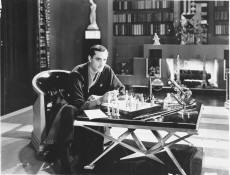
Vance studies the chess board to try to solve the mystery. |
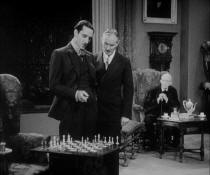
"The Black Bishop is one move away from the
Checkmate." |
"Basil Rathbone does a William Powell and a Philo Vance at one and the same
time. His Powell, however, is not quite as good as the original. His Philo Vance
is excellent." —The Talking Screen,
June 1930
The Bishop Murder Case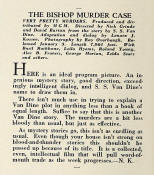 Here is an ideal program picture. an
ingenious mystery story, good direction, exceedingly intelligent
dialog, and S.S. Van Dine's name to draw them in.
There isn't much use in trying to explain a Van Dine plot in
anything less than a book of equal length. Suffice to say that this is
another Van Dine story. The murders are a bit less bloody than usual,
but just as effective.
As mystery stories go, this isn't as curdling as usual. Even though
your house isn't strong on blood-and-thunder stories this shouldn't be
passed up because of its title. It is a collected, even, intellectual
film that will pull word-of-mouth trade as the week progresses.
—N. K.
—Exhibitor's Herald-World, February 8, 1930 |
"The story is well worked out and the suspense is sustained." —National Board of Reviews, January 1930
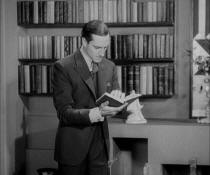
Vance discovers a clue to the identity of the murderer. |
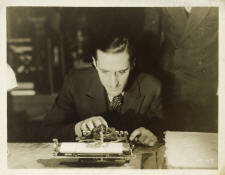
Vance tests the typewriter found in the attic. |
"This sophisticated mystery keeps the audience guessing until the motive is
revealed at the end. The slow pace allows the audience time to think and absorb
the somber mood." —Sanderson Beck,
Movie
Mirrors
Bishop Murder Case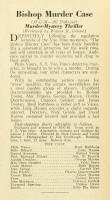 Definitely following the
regulation formula of the Van Dine mysteries, "The Bishop Murder Case"
has been finely handled. It's a substantial attraction for the week
runs, and will entertain in all types of houses. audience partial to
murder mysteries will cling to their seats.
Philo Vance, S.S. Van Dine's detective character, is brought in to solve
a murder. During the unraveling, four other characters are murdered.
With no outstanding picture names for "draw" qualities, the picture
nevertheless has a most capable group of players. Excellent
characterizations are provided by Roland Young, Alec Francis, George Marion,
Charles Quartermaine, Clarence Geldert and James Donlan. Basil Rathbone is
rather stiff as Vance, while Leila Hyams provides a slight romantic
interest. Directors Nick Grinde and David Burton sustained interest and
provided a fast tempo.
—Walter R. Greene, Motion Picture
News, November 16, 1929
|
Other Philo Vance films:
- The Canary
Murder Case (1929)
- The Greene Murder Case (1929)
- The Benson
Murder Case (1930)
- The Kennel Murder Case (1933)
- The Dragon
Murder Case (1934)
- The Casino Murder Case (1935)
- The Garden
Murder Case (1936)
|
- The Scarab Murder Case (1936)
- Night of Mystery (1937)
- The Gracie Allen Murder Case (1939)
- Calling Philo Vance (1940)
- Philo Vance's Gamble (1947)
- Philo Vance Returns (1947)
- Philo Vance's Secret Mission (1947)
|
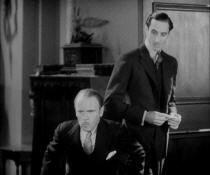
Is Arnesson guilty? |
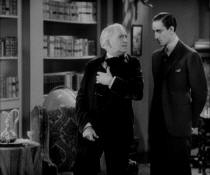
Prof. Dillard explains why he hates Arnesson. |
Return
to page one.
Go to Page Three for pictures of
lobby cards and promo photos.
|




















